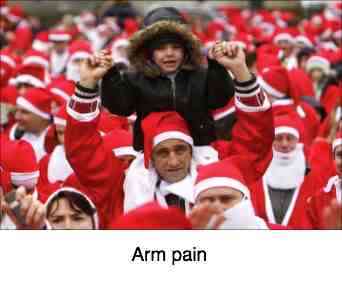Cervical compression test
The cervical compression test is used many times daily in every chiropractic clinic. Below is a magnificent video clip from Swan Lake showing how it is done in the arts; be sure not to miss it.
How is the procedure done? With the patient seated, the examiner gently applies axial, downward pressure on her head. First, do no harm, was Hippocrates' admonition; done too enthusiastically any orthopaedic test can worsen the condition.
The patient's head is grasped with both hands and gentle axial compression is applied.
- In the neutral position
- Rotated, first left and then right
- Laterally flexed, left and right
- Slightly extended.
- Rotation, extension + lateral flexion to the same side (Kemp's test)
Truly astonishing display of the Compression Test aka SWAN LAKE. Watch to the end.
Interpretation
- Increased Peripheral pain > Increased pressure on nerve roots (IVF encroachment, radiculopathy).
- Increased local pain > Joint damage, facet lock, meniscoid entrapment.
- Increased tingling or pain in the arm with the compression + Kemp's test is pathognomic of a nerve root impingement syndrome.
Whiplash and the joints of Luschka as well as facet syndromes and disc injuries should be considered. Why you should always consult a chiropractor after a motor vehicle or diving accident.
Clinical Notes
With radicular symptoms, further evaluation is warranted; a detailed neurological examination and diagnostic imaging.
From the coal face

"Doc, I have terrible pain in my arm?"
"When did it start, Mr Vermeulen."
"After we went to the Pink Pop concert."
"Did anything unusual happen?"
"I can't think of anything. It was quite a long and tiring day. The kids found it boring."
"How old are they? You didn't carry one of them on your shoulders by any chance?"
How bad is my arm pain?
The ache in the upper extremity is often severe, disturbing sleep. Unlike the leg, you
often can't find a comfortable position. Patients may think they must
be hypochondriacs. Almost certainly, they are not but the arm pain quickdash test gives you a pretty objective measure of how severe your condition is.
One possible mechanism
explaining the radiating arm after carrying a child on your neck
shoulders is the thoracic outlet syndrome.
An aching, painful arm is a frequent complaint heard at the chiropractic coalface. Sometimes it is caused by a compromise of the subclavian artery and brachial plexus as they emerge from the thorax.
Passing through the interscalene triangle, a muscle spasm or fixated first rib or fibrosis from an old fracture of the first rib or clavicle the vascular and neurologicasl structures may be compromised; a cervical rib too may be the spoke in the wheel, remembering that a large part of it may be cartilage and unseen on an xray.
THORACIC OUTLET SYNDROME ...Neck and arm pain
To reiterate, with any of the tingling, nerve-type pain syndromes of the arm, like
Carpal Tunnel Syndrome
for example, a thorough work of the cervical spine and first rib is mandatory. Neck and arm pain
is so common at the Chiropractic Coalface, and the root of many tennis
arm, rotator cuff and frozen shoulder type syndromes is very frequently
in the cervical spine.
CHIROPRACTIC MAINTENANCE CARE
Like all chronic medical conditions, no one is able to cure chronic neck pain. Research shows once you have had neck pain for six months, you will almost certainly have it for the rest of your life. And if you have had it for four months, what then? Do something now, or it is for ever.
Neck pain for more than six months? Chiropractors agree that chronic neck pain is best managed with an occasional, but regular, treatment.
Nevertheless chiropractic maintenance care remains controversial.
Cervical compression test
Cervical compression test is a lighthearted look at a very basic procedure. This is great fun.
Did you find this page useful? Then perhaps forward it to a suffering friend. Better still, Tweet or Face Book it.
